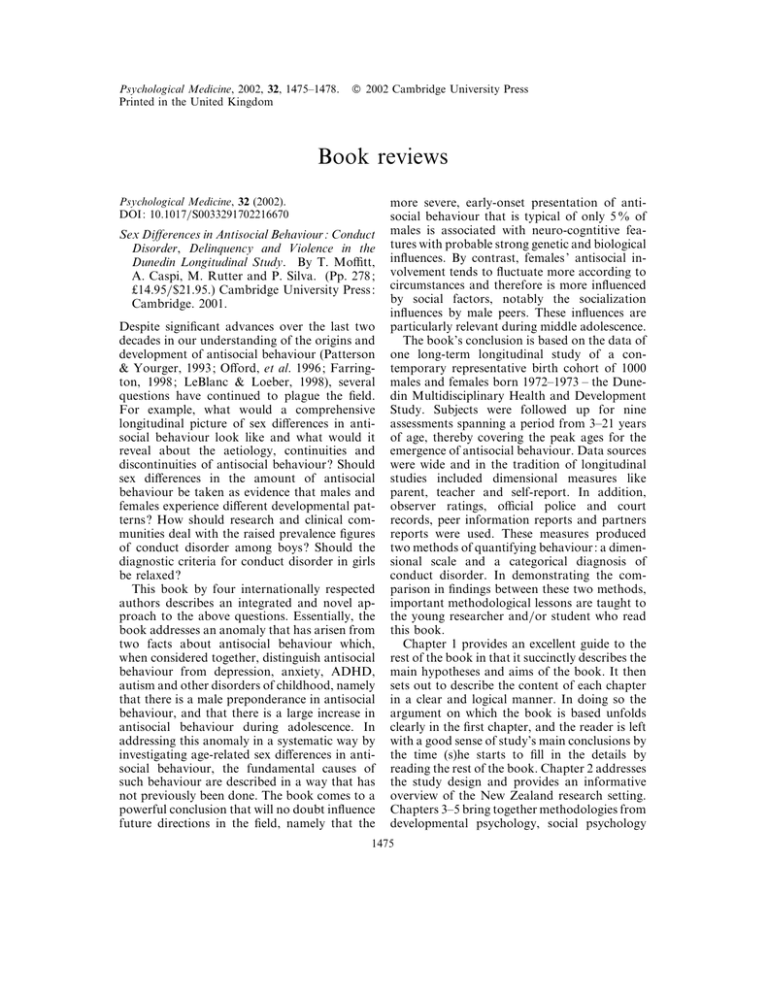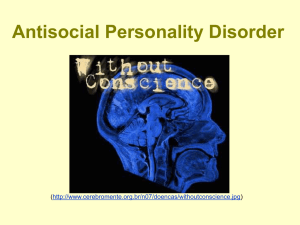Book reviews more severe, early-onset presentation of anti-
advertisement

Psychological Medicine, 2002, 32, 1475–1478. Printed in the United Kingdom " 2002 Cambridge University Press Book reviews Psychological Medicine, 32 (2002). DOI : 10.1017\S0033291702216670 Sex Differences in Antisocial Behaviour : Conduct Disorder, Delinquency and Violence in the Dunedin Longitudinal Study. By T. Moffitt, A. Caspi, M. Rutter and P. Silva. (Pp. 278 ; £14.95\$21.95.) Cambridge University Press : Cambridge. 2001. Despite significant advances over the last two decades in our understanding of the origins and development of antisocial behaviour (Patterson & Yourger, 1993 ; Offord, et al. 1996 ; Farrington, 1998 ; LeBlanc & Loeber, 1998), several questions have continued to plague the field. For example, what would a comprehensive longitudinal picture of sex differences in antisocial behaviour look like and what would it reveal about the aetiology, continuities and discontinuities of antisocial behaviour ? Should sex differences in the amount of antisocial behaviour be taken as evidence that males and females experience different developmental patterns ? How should research and clinical communities deal with the raised prevalence figures of conduct disorder among boys ? Should the diagnostic criteria for conduct disorder in girls be relaxed ? This book by four internationally respected authors describes an integrated and novel approach to the above questions. Essentially, the book addresses an anomaly that has arisen from two facts about antisocial behaviour which, when considered together, distinguish antisocial behaviour from depression, anxiety, ADHD, autism and other disorders of childhood, namely that there is a male preponderance in antisocial behaviour, and that there is a large increase in antisocial behaviour during adolescence. In addressing this anomaly in a systematic way by investigating age-related sex differences in antisocial behaviour, the fundamental causes of such behaviour are described in a way that has not previously been done. The book comes to a powerful conclusion that will no doubt influence future directions in the field, namely that the more severe, early-onset presentation of antisocial behaviour that is typical of only 5 % of males is associated with neuro-cogntitive features with probable strong genetic and biological influences. By contrast, females ’ antisocial involvement tends to fluctuate more according to circumstances and therefore is more influenced by social factors, notably the socialization influences by male peers. These influences are particularly relevant during middle adolescence. The book’s conclusion is based on the data of one long-term longitudinal study of a contemporary representative birth cohort of 1000 males and females born 1972–1973 – the Dunedin Multidisciplinary Health and Development Study. Subjects were followed up for nine assessments spanning a period from 3–21 years of age, thereby covering the peak ages for the emergence of antisocial behaviour. Data sources were wide and in the tradition of longitudinal studies included dimensional measures like parent, teacher and self-report. In addition, observer ratings, official police and court records, peer information reports and partners reports were used. These measures produced two methods of quantifying behaviour : a dimensional scale and a categorical diagnosis of conduct disorder. In demonstrating the comparison in findings between these two methods, important methodological lessons are taught to the young researcher and\or student who read this book. Chapter 1 provides an excellent guide to the rest of the book in that it succinctly describes the main hypotheses and aims of the book. It then sets out to describe the content of each chapter in a clear and logical manner. In doing so the argument on which the book is based unfolds clearly in the first chapter, and the reader is left with a good sense of study’s main conclusions by the time (s)he starts to fill in the details by reading the rest of the book. Chapter 2 addresses the study design and provides an informative overview of the New Zealand research setting. Chapters 3–5 bring together methodologies from developmental psychology, social psychology 1475 1476 Book reviews and criminology and thereby provide the most comprehensive picture in existing literature of overall sex differences in the amount of antisocial behaviour. The most interesting finding here, and on which the study builds throughout the rest of the book, is that the male preponderance is most evident with respect to early-onset lifecourse persistent antisocial behaviour. Thus, life course persistence is the feature that best distinguishes between males and females. In Chapters 6 and 7 the issues of developmental stability and age of onset of antisocial behaviour are addressed. In Chapters 8–10 different aspects of the issue of sex-differentiated and sex-similar risk factors, including personality are dealt with. Chapters 11, 12 and 15 deals with issues of the co-morbidity and diagnosis of conduct disorder, while Chapter 13 and 14 addresses adult outcomes of child antisocial behaviour. The findings reported in these chapters work up to the final and powerful conclusion in Chapter 16, which alludes to the sex-differences associated with life-course persistent and adolescence-limited antisocial behaviour described earlier in this review. Chapter 17 concludes with a clear summary of the results and a helpful outline of research lessons and aims presented in a pedagogical style. Despite its comprehensive nature and the consideration given to early neurocognitive and family risk predictors, one aspect that lacked in the study itself as well as in the discussion of results is the possible role that affective factors may play in the development of antisocial behaviour. A discussion about the aetiology of antisocial behaviour seems incomplete without reference to aspects like attachment and emotional processing. Through its sound methodology and clear description of method and rationale, this must-read book is appropriate for established researchers and\or students interested in prediction studies of the childhood correlates of later health and behaviour outcomes, developmental studies of continuity and change in health and behaviour, and epidemiological studies of the prevalence and incidence of health problems and behaviour problems. More specifically, it provides students of psychiatry, psychology and criminology with an excellent example of how to study sex-differences in any behaviour. Moreover, the book is a pleasure to read. This is facilitated by the fact that each empirical chapter is organized like a traditional research report and ends with ‘ take-home messages ’ and ‘ unanswered questions’. At the risk of producing too long a book, one aspect that might have added to its clarity would be the inclusion of examples of the measures used in the study. However, the research community will wait in expectation for a follow-up work of this quality with the rest of the Dunedin study results. REFERENCES Farrington, D. P. (1998). Predictors, causes, and correlates of male youth violence. In Crime and Justice : A Review of Research, Vol. 24 (ed. M. Tonry and M. H. Moore), pp. 421–475. University of Chicago Press : Chicago. LeBlanc, M. & Loeber, R. (1998). Developmental criminology updated. In Crime and Justice : A Review of Research, Vol. 23 (ed. M. Tonry and M. H. Moore), pp. 115–198. University of Chicago Press : Chicago. Patterson, G. R. & Yourger, K. (1993). Developmental models for delinquent behaviour . In Crime and Mental Disorders (ed. S. Hodgins), pp. 140–172. Sage Publications : Newbury Park, CA. Offord, D. R., Boyle, M., Campbell, D., Goering, P., Lin, E., Wong, M. & Racine, Y. A. (1996). One-year prevalence of psychiatric disorder in Ontariars 15 to 64 years of age. Canadian Journal of Psychiatry 41, 559–563. Psychological Medicine, 32 (2002). DOI : 10.1017\S0033291702226677 Addictions : A Community Reinforcement Approach to Addiction Treatment. Edited by R. J. Meyers and W. R. Miller. (Pp. 188 ; £49.95\$74.95.) Cambridge University Press : Cambridge. 2001. Nearly three decades ago, research began unfolding the relationship of social contextual reinforcers role in competing with reinforcement experienced from alcohol use. But after all this time is there still a need for a book summarizing a community reinforcement approach (CRA) to addiction treatment ? The answer is undoubtedly ‘ yes ’. For some explainable reasons and others unknown, the field has lagged in its acceptance of broader implementation of this research in practice. CRA’s roots are founded in learning theory, particularly, the operant approach described by Skinner in 1938. To treat alcohol and other drug problems, the therapist helps the patient make changes in their daily environment to reduce substance use and promote a healthier lifestyle. Book reviews Substance use is seen as being maintained by the reinforcing properties of its subjective effects, social rewards, physical sensations, and dependence inducing qualities. The premise of CRA is that the patient is deterred from substance use when use interferes with other sources of satisfaction and positive reinforcement in their environment. Therefore, substance use is reduced if reinforcers for abstinence, such as satisfying work or improved social relationships are capitalized, frequent, and contingent upon not using. CRA attempts to reorganize these contingencies so that substance free behaviour is more rewarding than drug or alcohol use. This approach is particularly refreshing because it allows for a positive method to addressing substance use that could have multiple long-term benefits beyond the cessation of substance use. It also challenges our conceptions of adequate treatment to encompass innovative approaches that address many aspects of our patients’ lives. Drs Meyers and Miller have assembled a comprehensive, highly informative book that is invaluable to individuals looking to be introduced to the history of this approach and learn the therapeutic techniques involved. Nine chapters written by 10 different authors are organized to easily move the reader from the development of CRA to testing its efficacy and application to broader populations who abuse substances while introducing new techniques to advance its effects. A certain degree of redundancy is inevitable in compilations such as this, due to overlap of technique with augmentations or minor adaptations for special populations. Nonetheless, all central themes are addressed in ways that are intriguing and of practical use to the reader. The initial chapter on CRA’s development is written in a detailed manner that leaves the reader feeling close to the movement from the personal histories of the early developers such as Hunt and others allowing for a unique perspective of the underpinnings of this movement. Following, one becomes struck by CRA’s effectiveness in reducing alcohol use in chronic patients in the initial Azrin studies discussed in chapter two. Within chapter three, an excellent review of the techniques involved in CRA treatment is provided. Useful clinical examples 1477 are illustrated complete with blank and filled out forms and assessments commonly used in the delivery of CRA treatment. This chapter is particularly helpful to individuals who are looking for a crash course in delivering this treatment. A well organized presentation of the scientific shortcomings of the initial studies occurs in chapter four detailing how these issues are addressed in more recent randomized controlled trials in chapter five. These chapters provide answers to the many lingering questions that occur after scrutinizing the initial study designs of CRA allowing for the further examination of the parameters of the positive effects of CRA and its active ingredients. In chapters six, seven, and eight, the authors demonstrate the broad applications of CRA with special populations such as homeless and cocaine and opioid dependent individuals and the use of CRA with family to engage the patient in treatment. CRA is one of a handful of treatments that have empirical support in treating substance abuse as discussed in Sequeland and CritsChristoph’s review in 1999 which begs the question of why it has not been more widely adapted. In the final chapter of the book, the following are discussed as potential explanations : limited access to CRA training, high acceptance of the American-style disease model, effort involved with learning new treatments, no sexy elaborate intrapsychic theories exist, and therapists often think they are already conducting CRA when in fact they are not. Many of these issues are directly addressed in this book. This volume serves as a useful guide to exposing individuals to a successful treatment that effectively reduces alcohol and drug abuse. It should go a long way in reviving the field’s interest in CRA. Psychological Medicine, 32 (2002). DOI : 10.1017\S0033291702236673 Textbook of Community Psychiatry. Edited by G. Thornicroft and G. Szmuckler. (Pp. 585 ; £750.) Oxford University Press : Oxford. 2001. The editors of this book believe that the time is right for a textbook for the emerging discipline of community psychiatry. In so doing they 1478 Book reviews assert that the subject has enough of a scientific base and sufficient clinical relevance to warrant a traditional style multi-author medical textbook. The editors begin by defining community psychiatry as ‘ the principles and practice needed to provide mental health services for a local population by establishing population-based needs for treatment and care ; providing a service system linking a wide range of resources of adequate capacity, operating in accessible locations ; and delivering evidence-based treatments to people with mental disorders ’. The book is divided into two major sections, described as psychiatry for the community and psychiatry in the community. The shorter first section covers the social policy context and the scientific method as it can be applied to community psychiatry. It goes on to cover how the population needs for psychiatric care can be determined. The larger second section deals with how mental health services are designed to meet population needs, that is, the question of service delivery. Included in this section are chapters on planning and integrating services, the components of a community mental health service, the boundaries between general and specialist services, the roles of users and carers and the prevention of mental disorder. There is a final short section, which discusses ethical issues as they relate to community psychiatry, for example, rationing and compulsory treatment. The textbook declares itself to be an international review of community psychiatry, but understandably there is a clear UK bias. The majority of the chapter authors are from the UK and while many chapters cover the international research evidence, many assume an entirely British perspective. Indeed, the glossary at the end of the book is mainly concerned with describing the meaning of many of the new acronyms that plague the British NHS : NICE, PCG, NSF and so on. To consolidate the international outlook, it would have been useful to include a review of how community psychiatry has developed in differing national health systems. Many readers would assume that this text would cover in detail the research evidence for alternatives of hospitalization and other new forms of service delivery in the community. The chapter on assertive community treatment by Scott and Lehman provides a good review here, albeit from a predominantly US perspective. However, discussion of the major UK hospital diversion and community care studies is scattered across many different chapters and the absence of a final author index makes it difficult to keep track of them. Of course, the most recent UK evidence, for example, the UK700 study is not reviewed. In relation to the service system, the chapters by Thornicroft and Tansella on planning services and those chapters by Burns and others on integrating service components are excellent. The editors do not tell us who their target audience is. Textbooks are usually the domain of medical students and postgraduate trainees, but this book is probably too specialized and too expensive for a trainee’s personal library. Service planners, adult consultant psychiatrists and higher specialist trainees in the UK will find much of interest here, particularly where they are looking to develop or evaluate new service provision. I think international readers will be somewhat disappointed by the concentration on the particular issues that arise within the British National Health Service. Overall, as is the case with most large multi-author textbooks, there are some chapters that provide well-written authoritative reviews and some that do not seem to relate well to the overall theme. But it has certainly been worth the effort of the editors to produce this textbook of community psychiatry and I would recommend it for psychiatric libraries. .

